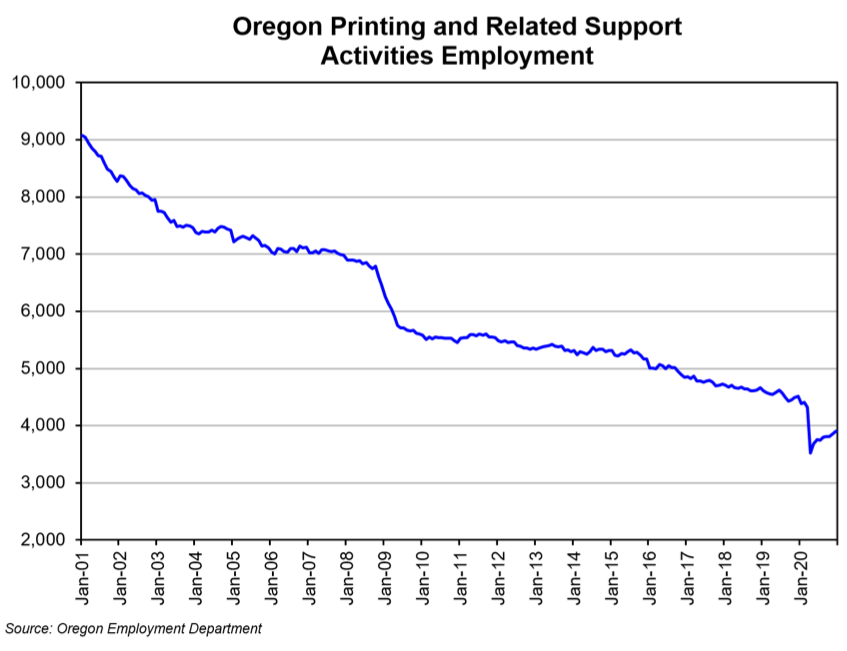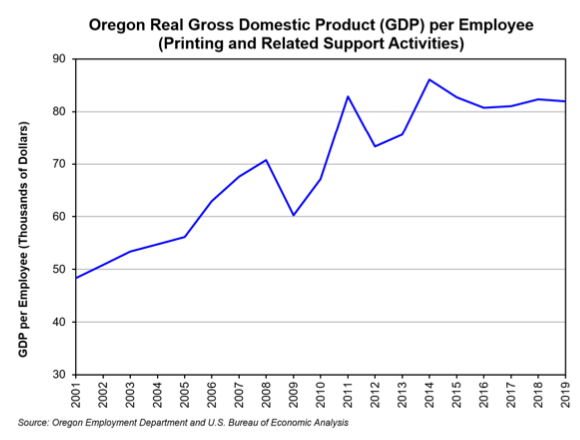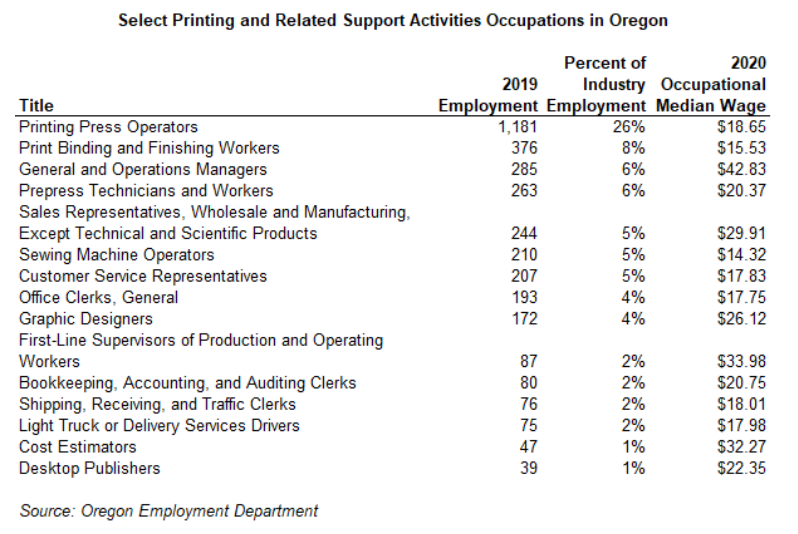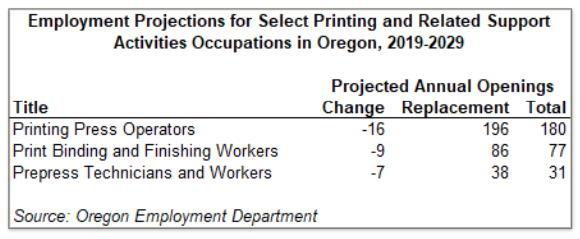Technology Reduces Employment in the Printing Industry
by Brian Rooney Regional Economist Douglas and Lane counties brian.t.rooney@oregon.gov

Employment in printing and related support activities has been on the decline since the late 1990s. Advances in digital technology have contributed to declines in employment in two important ways. First, by changing the marketplace the industry operates in as options to deliver information become more diverse. And secondly, by improving productivity so the industry needs fewer workers to do the same amount of work.
Firms in the printing and related support activities industry (which will be referred to as the “printing industry”) print products, such as newspapers, books, periodicals, business forms, greeting cards, and other materials, and perform support activities, such as bookbinding, platemaking, and data imaging. Newspapers and other publishers that do in-house printing are classified in the publishing industry of the information sector and are not included here.
An Industry in Long-Term Decline

Employment in the printing industry has been declining for more than a decade, but it remains an important industry in Oregon, employing about 3,900 in 2020.
Annual average employment in the industry has dropped about 55% since 2001. Going further back in time, employment in commercial printing had increased until the mid-1990s. It then leveled off for a few years before starting a slow decline in the late 1990s. The decline accelerated during the early part of the 2000s. After a relatively stable period between 2006 and 2008, the industry, like most in manufacturing, was hurt by the Great Recession. Afterwards, employment was relatively stable, declining slowly over the next seven years. The printing industry again lost jobs at the onset of the COVID-19 pandemic, losing roughly 900 jobs between February and April 2020. It has since regained some of the loss to reach about 3,900 jobs by December 2020.
The support activities for printing subsector is relatively small, with an annual average employment of 98 in 2020, down 88% from the 812 recorded in 2001.
Technology and the Printing Industry

Through history, from ancient Chinese block printing, to Johannes Guttenberg’s movable type press, to lithographic offset printing, to today’s digital printing, technological advances have made printing more productive and of higher quality, increasing the availability of information.
Today, however, other forms of media are distributing information at an increasing rate. First radio, then television, and now the Internet and e-books have taken market share. This has reduced the demand for printed material and contributed to the decline of industry employment.
Although some in-house newspaper printing is not included in this industry, the decline of newspaper circulation is a prime example of how technology has reduced the demand for printed material. Online news has many advantages. It is often free of charge, has a wider range of information available, and the ability to provide updates several times a day. This has pushed people online for their news and away from print newspapers. According to the Newspaper Association of America, paid circulation began to drop in the late 1980s. Between 1990 and 2014, weekday circulation in the U.S. dropped from 62,328,000 to 40,420,000, a loss of 21,908,000 or 35%. According to estimates from the Pew Research Center, weekday circulation (both print and digital) had dropped to 28,554,137 by 2018.
Another way technology can reduce employment is through increased productivity. In many manufacturing industries, improvements in productivity eventually make the industry less labor intensive, reducing employment. One measure of productivity is the output per worker. The second graph measures productivity as the inflation adjusted contribution per worker of the industry to Oregon’s gross domestic product. It shows that except for the recessionary period from 2008 to 2009 and again in 2012, the printing and support activities industry has generally increased productivity, going from a little over $50,000 per worker per year in the early 2000s to more than $85,000 per year by 2014. It has since leveled out at a little more than $80,000 per worker. Although productivity can be increased in other ways, it is largely due to better technology.
Occupations in the Printing Industry

The largest occupations in the printing and related support activities industry are production workers. These are workers who do the printing, binding, and prepress work. Not surprisingly, the largest occupation is printing press operator, which makes up 26% of the industry’s employment. The next largest occupation, bindery workers, makes up 8% of the industry. These workers take the printed materials and bind them into books and other publications
The first table lists the largest 17 occupations in the printing industry and their wages. The wages listed are for all industries that include the occupation, not just printing and support activities. Wages in the printing and support activities industry are midlevel. The 2020 average annual pay for the industry is $47,498 compared with an overall statewide wage for all industries of $59,918. However, wages in the industry are low for a manufacturing industry. Overall, manufacturing has an average annual wage of $74,916.
Most occupations in printing production, such as printing machine operators and bindery workers, require only a high school diploma and moderate on-the-job training, and tend to pay below the industry average. Others, like prepress technicians and graphic artists, may require education beyond high school and involve artistic skills. These occupations generally pay higher wages.
Outlook
According to the Bureau of Labor Statistics, national employment in the printing and related support activities industry is expected to decline by roughly 19% between 2019 and 2029. Continued loss of market share to other media and continued automation causes net overall employment to decline in the future, which is about the same pace as recent years. In the 10 years between 2009 and 2019 the industry declined by about 19%.
Demand for some forms of printed material like packaging and direct mail advertising that are not as susceptible to replacement by electronic formats is expected to increase along with economic and population growth. This will moderate the losses from technical advances expected elsewhere in the industry.
Most occupations in the printing industry in Oregon are expected to decline. However, with an aging labor force, retirements will help provide opportunity. These opportunities show up as replacement openings in employment projections. The second table shows the expected employment change and replacement needs of occupations most directly related to printing and support activities. These occupations are expected to have no openings created by growth, but are expected to provide opportunity through replacement openings.
Conclusion
After years of decline since the 1990s, and a big drop during the Great Recession and a smaller one due to COVID-19, the long-term projection is for future advancements in technology to further reduce employment in the printing industry. Still, printed products will have a place in our economy for a long time to come. In the future, declines in printing-industry employment are expected to continue at about the same pace as the past decade.


Advertisement